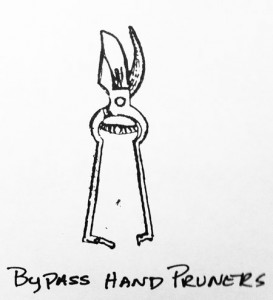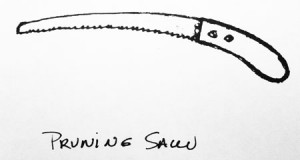Newly designed chainsaws are now available for residential scale projects that are lighter weight and are equipped with better safety features. However, pruning with a chainsaw is not recommended. Any tree work that requires a chainsaw is best done by an experienced arborist. Never attempt to use a chainsaw for a job that requires climbing a ladder.
Choose pruning tools that are comfortable for you. Manufacturers make hand pruners for left handed people and those with small hands. Some styles of hand pruners are ergonomic. They have a rotating handle that makes them easier to use. Some lopper handles have gearing or ratchet action to reduce the pressure needed to close the blades.
The most important thing is to buy as high quality tools as you can afford and keep them sharp. Dull pruning blades will pinch or tear branches, leaving a damaged, ragged wounds rather than clean cuts. They are more vulnerable to rot and insect infestation. Consider purchasing a sharpener for your pruning tools. Have them professionally sharpened periodically or purchase new ones. Some higher end brands sell replacement blades and other parts for your pruners.
Hand pruners
A good pair of hand pruners is indispensable for pruning jobs. The bypass style is the type to get. Its blades work like scissors, the top one, sharpened for cutting, is designed to pass by a lower “hook” blade. This makes a straight, clean, close cut on branches that are no larger than one or two inches (depending on the hardness or softness of the wood) in diameter.
You will see anvil style hand pruners for sale. They have a straight upper blade which strikes the bottom one. Because they tend to squeeze or crush a branch, rather than cut through it cleanly, these anvil pruners are used mostly on dead trees or branches where a clean-cut wound is not needed.

 Pruning saws
Pruning saws
Saws designed for pruning are different from wood saws used on lumber. They are used for cutting branches that are 3 or more inches in diameter. Available in many styles featuring either straight or curved blades that narrow to a point at the end, their blades may be from 9 to 15 inches long. Their handles may be plastic or wooden, some curved, or with a D-grip; others slotted to accommodate folding blades.  Pruning saws have fairly coarse teeth and sometimes a raker to clean sawdust out of the teeth as it cuts. For larger limbs, well over 3 inches in diameter choose a D-grip straight pruning saw.
Pruning saws have fairly coarse teeth and sometimes a raker to clean sawdust out of the teeth as it cuts. For larger limbs, well over 3 inches in diameter choose a D-grip straight pruning saw.
Another saw style, the bow saw is less useful for pruning. It is useless where branches are close together.
 Lopping shears
Lopping shears
Lopping shears are designed to handle somewhat larger branches than hand pruners can cut—up to 3 inches in diameter. They feature larger blades and long handles which provide more leverage for cutting through the thicker wood. Their blades come in bypass or anvil style and sometimes employ ratchets or a compound action design using several pivots like a bolt cutter. Choose loppers with steel, ash or hickory handles, bolted or riveted to the blades. Always open the blades wide so that the branch is well in between them before starting to close the handles to cut.
Lever-action pole pruners
These tools are basically a pruning blade, either bypass or anvil, mounted at the end of a long pole to facilitate cutting a high branch while standing safely on the ground. They sometimes have optional saw attachments on them as well. The pruning blades are closed to cut a branch by a rope that is connected to a pulley and lever near the blades at the top and then clings down the length of the pole to where the user can pull it. Sometimes the poles are wood, sometimes metal. Metal ones are not safe to use near power lines. Typically, pole pruners will cut branches up to 3 inches in diameter. The saw on the pole will cut slight larger ones.

